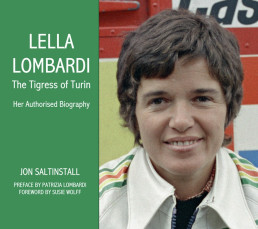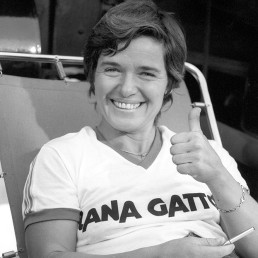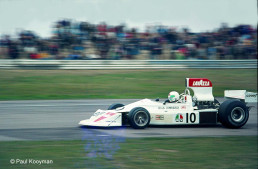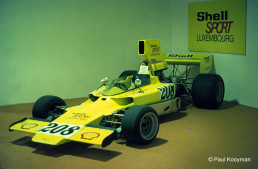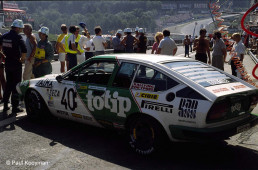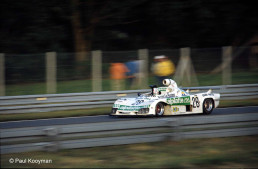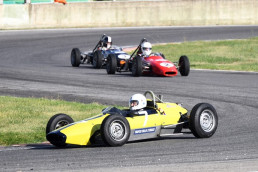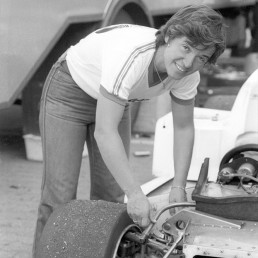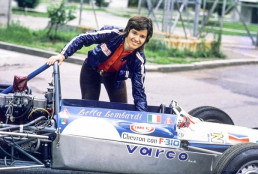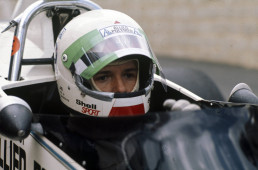So, who was Lella Lombardi? (and why is it so difficult to find out about her?)
Since the inauguration of the F1 World Championship for Drivers in 1950, nearly 900 drivers have attempted to qualify for the starting grid. Only 5 of these have been women, just 2 of whom have managed it. With 17 entries and 12 starts, by far the most successful of these women is Lella Lombardi. For many who know of her only through motor sport trivia books or quizzes, she is “the only woman to have finished an F1 Grand Prix in a points-scoring position”, but this record – remarkable as it is -does her a disservice, as it overshadows the rest of her 23-year career.
I first became aware of Lella in 1974, thanks to a double-page advert in Autosport magazine devoted to the woman who was about to attempt to qualify for the British Grand Prix. Further investigation revealed that she was giving a good account of herself in F5000 that year, earning her stripes in the big, unwieldy single-seaters. She remained on my radar sporadically after her brief F1 career ended, although many contemporary magazines gave few column inches to her exploits in other categories.

When I read of her passing in 1992, at the tragically young age of 50, I learned from her obituaries that she had been Italian national F.850 champion in 1970; winner of the Ford Escort Mexico Kleber Challenge title in 1973; had shared the highest-placed finish post-war by an-all female crew in the Le Mans 24-Hours (with Christine Beckers in 1977). I already knew that she had claimed three outright victories in the World Sports Car Championship, which she’d followed up with numerous class wins in the European Touring Car Championship and the 1985 Division 2 ETCC Crown (with Rinaldo Drovandi). This seemed a pretty impressive record for any driver, but despite that, and Lella’s significance to the sport for gender-obsessed F1 statisticians, it baffled me for years to follow as to why there had never been a biography written about her, not even in her native Italy.
After a later-life epiphany as a motor sport writer, when BHP Publishing offered me the opportunity to write about “whomever I wanted”, I jumped at the chance to produce her biography. Very quickly, it became apparent why nobody had attempted it before. Lella gave very few interviews during her lifetime and largely kept herself to herself. Her career spanned the years 1965 to 1988, and for a devout Roman Catholic from a then very traditional Italy, the fact that she was also gay meant that she built a defensive wall around her personal life. This was to protect her partner Fiorenza, who was a constant presence alongside her from the very earliest days of her career, and helped her acquire her first racing car in 1965, an F.875 CRM, to learn her craft in the new “Formula Monza” that was launched that year. Lella’s guarding of their life together was so effective that many of the Italian journalists who knew the couple well enough to be invited for dinner at their home, never knew Fiorenza’s surname.
The daughter of a butcher from the tiny village of Frugarolo, near Alessandria Lella was a natural athlete and became a capable handball player. She helped her father to negotiate with traders at the wholesale meat markets, while racing her Lambretta against the village boys. A request from the local priest to tame her wild ways fell on deaf ears. She was the first person in her family to hold a driving licence, having learned at the wheel of the butcher’s van, and there are several hair-raising stories of her adventures making deliveries along the Ligurian peninsula.
Most photos of Lella show her in either racing overalls or jeans and sweatshirts. It was a surprise to discover that before she became a racer, she was a very accomplished jive dancer; she and her childhood friend Giuseppe Bonadeo won many local and regional dance contests. Discovering a photo of her in a party dress was almost disconcerting! It was also interesting to learn that her favourite pastime when she was not racing was fishing.
Her friends reflect on the fact that – outside her local territory – the Italian mass media gave little space to Lella’s exploits, and she seems to have received much greater press attention in both the UK and Australia, where she was very popular after two exceptional F5000 outings. What is equally clear, however, is that despite her talent and tenacity as a racer and the quality of her technical feedback, Lella’s career during the 1960s and 1970s was hamstrung by a combination of misogyny and inattention from some team owners. In one of her rare interviews, she told how she hated the condescending smiles from some male rivals at the start of her career, with the patronising suggestion, “I’ll help you because you’re just a woman who won’t be able to do this alone.” Other than that, she rarely complained about the way she was treated by her male rivals.
When she eventually reached F1, in mid-1975, she was soon frustrated with her March’s perpetually inconsistent handling which showed no improvement regardless of any set-up changes, A well-documented story recounts that the reason for her car’s mysterious handling only came to light when her successor at March, Ronnie Peterson, reported the same issue when he was given Lella’s former chassis to drive in 1976. When the tub was stripped down at the factory, a cracked internal bulkhead was found, by which time the damage to Lella’s F1 reputation had been done. March boss Robin Herd later admitted, ‘It was one of the few times that she complained about the inequality of F1 – because nobody had listened to her about the problem with the car.’
Gender was something that never concerned her; after her F1 debut in 1975, she told a local reporter, “I hope that, now, people have begun to understand that Lella Lombardi is a racer who is a woman, rather than a woman who races. That is a distinction that I care about very much.’ Later that year, in Autosprint, she claimed, ‘I have never considered the male-female issue, only the competition that exists between different drivers. Under the helmet, women and men are completely equal.’
One of the recurring themes from the hundred-plus interviews I conducted whilst researching Lella’s story is that nobody had a bad word to say about her. This is especially unusual in the dog-eat-dog world of professional motorsport where feelings and opinions are amplified by rivalry. She was a quiet force of nature, tenaciously determined to follow her passion for racing above all else, even in this meant making great personal sacrifices with limited financial resources. Her technical ability is often mentioned and her excellent mechanical sympathy was appreciated by her prototype and touring car co-drivers. She was quick, too, as evidenced by seventeen career pole positions and twenty fastest laps.
The ups and downs of Lella’s career, with all its attendant challenges and setbacks, read like a Hollywood film script, but it’s one that also has a tragic ending. Having recently formed her own team, Lella Lombardi Autosport, ill-health forced her to retire from racing early in 1988. The pain she thought was due to a sailing injury incurred three years previously turned out to be breast cancer, and she passed away peacefully in Milan’s San Camillo Clinic in March 1992, three weeks before her 51st birthday. I am tremendously grateful to the many friends, family members, former colleagues and rivals, and – particularly – to Lella’s niece Patrizia for their help and support in creating a properly three-dimensional image of this remarkable racer.
“Lella Lombardi: The Tigress of Turin, Her Authorised Biography” by Jon Saltinstall will be published by BHP Publishing in August 2025.
© Jon Saltinstall, 2025.
Interview with Barbara Gramolotti
How did you come into contact with the story of Lella Lombardi to the point of becoming passionate about it?
I am in charge of territory promotion for the Novese district.
While reading a book that told about Lella Lombardi, I realized how exceptional she and her story were.
Deepening my interest in this story, I continued to inform myself and realized that there was never any story told about her. Hence my enthusiasm to find out more, delve deeper and get to know who Lella Lombardi really was.
To find out more about Lella Lombardi’s story, I got in touch with Giusy of Lella Lombardi Autosport and from there the idea of organizing something to remember Lella Lombardi was born.
The idea slowly took shape, organizing an exhibition at the Campionissimi museum in Novi ligure.
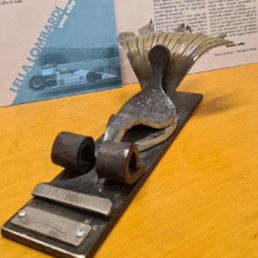
In addition, to keep Lella Lombardi’s memory alive, but above all to make people know her courage, tenacity and grit on the track, I had a Piedmontese blacksmith make a model of her car to hand it over each year as a symbolic recognition from the Novese district to the emerging driver who will have distinguished himself/herself for the grit and passion on the track, remembering Lella Lombardi’s strength and tenacity so as to carry on her name and pay homage to her.
To enrich the event, I tried to invite people close to her and to collect some memorabilia, such as racing suits and I tried to contact Lavazza for the helmet she used to race, but that collection had now gone to auction.

During the soiree dedicated to Lella Lombardi at the Campionissimi museum, you witnessed the multi-voice narration of those who knew her at different stages of her sporting life, what struck you most about Lella’s stories that evening?
They were all very happy, finally satisfied and excited to rightly recognize Lella, her personality, her achievements. They were all thrilled to participate in the evening, because it is right to shine the spotlight on someone who has had such a success story as a driver and not only.
It was exciting, there were people of all ages, let’s hope that such an event can be repeated in the future. Perhaps with even more people to make her story known and appreciated even more.
A very touching moment was watching the video of the day in Barcelona where she scored the emotional half a point, Giusy with her eyes shining; it was impressive to hear about her great feat and then to talk about it at the Campionissimi Museum, because it seemed as if we were witnessing the accomplishment of something great and beautiful.
The exhibition was a great success. There were so many visits from Turin and neighbouring countries, but also from Lombardy.
After delving into Lella Lombardi’s story, how would you describe her? Do you know any anecdotes?
After delving into her story and getting in touch with those who knew her, I was able to get to know Lella more from a human point of view as well.
Giusy tells of Lella as a very humble person with extraordinary skills, shy and insecure in private but not when driving. In fact, she was nicknamed ‘a tiger from Turin’ because once she was driving, all fear disappeared.
She also recalls another episode that demonstrates the humility and insecurity of this woman. Let me preface this by saying that at that time Lella was ill with cancer, the disease that took her away when she was still too young. They were in a restaurant, Lella and Giusy, and a gentleman was staring at her. Giusy immediately said ‘He recognized you! He wants your autograph!”, but Lella thought she was in disarray because her wig was on wrong. So much so that she was shy and uncomfortable, she couldn’t even eat because he was looking at her. Giusy went to the gentleman and he confessed that he was a Formula 1 enthusiast and that he had recognized Lella at a glance and wanted an autograph.
Even this short anecdote underlines the simplicity of a humble woman who was not used to posing, even after all her achievements as a driver.
She always had the strength to fight for her passions against everyone, even her homecountry. Initially, she preferred to hide so that no one would know she was going racing. For the first races she bought her car in instalments. This once again shows her humility, but also the strength to bet everything on her dream. Intimately, she was a very fragile and humble person, but quite another thing on the track. We can say two people in one.
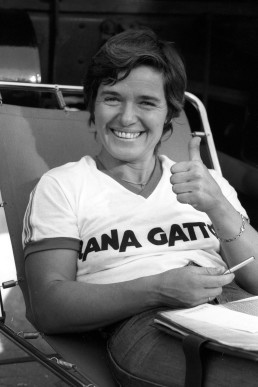
Barbara Gramolotti is in charge of territory promotion for the Novese district.
Interview with Fabrizio Viscardi
I had the opportunity to race with Lella Lombardi in 1966 in the F.875 Monza single-seaters. These races took place both day and night. At Monza and Vallelunga.
This propaedeutic formula certainly did not get drivers used to controlling the big powers. However, it had the notable merit of accustoming the drivers to managing the races, considering the constant presence of groups of cars with whose drivers there was repeated confrontation on the track. Therefore, it was necessary to constantly manage the continuation of the race with lucidity and detatchment even with the great risk of creating accidents, which, moreover, were quite frequent due to some rather exuberant drivers.
These were special single-seaters: they were derived from a Fiat “giardinetta” from which they drew all the essential components. For example, the braking system was considerably oversized in relation to the fact that the single-seater F Monza had a mass of only 400 kg; this meant that it had to be used very carefully when braking at the limit, due to the risk of lock-ups and therefore transforming rolling friction into sliding friction with clearly negative consequences. Also, the power-to-weight ratio was not great, practically one HP per 10 kg of mass, and this implied particular driving care so as not to waste energy in useless drifting or anything else.
I don’t want to dwell too long on technical issues that would be misleading in this case. However, they make us understand that these single-seaters did not perform best with impetuous drivers, but rather with thoughtful drivers accustomed to coolly and professionally resolving all race situations, which were constantly evolving as the laps went on. I would like to point out that Lella had all those characteristics necessary for a driver to have a following in the professional activity, something which then happened to this singular girl, a car driver.
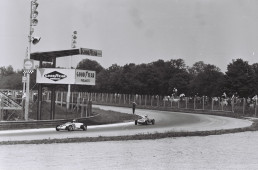

I remember her as a seemingly petite and fragile girl but, in reality, she was a determined person, willing to make motor racing her raison d’être.
Lella was of such an extreme fineness, grace and kindness but, nevertheless, she was stubbornly determined to pursue the goals she had set for herself in spite of the terrible difficulties that such a profession implied and still implies today.
When I saw single-seater No. 29 next to me during the race, I knew it was Lella and that made me very calm because the presence and proximity within a few metres of a driver with the head of a true professional was a reason for me to enjoy the race that was going on under the wheels!
These single-seaters, even back then, were not always anthropometric in their behaviour, so that the drivers’ bodies were subjected to forces that resulted in tension in several areas, e.g. shoulders, arms and back. The best prepared and most responsive drivers were the most ‘athletic’ones and those with perfect mental and neurological systems.
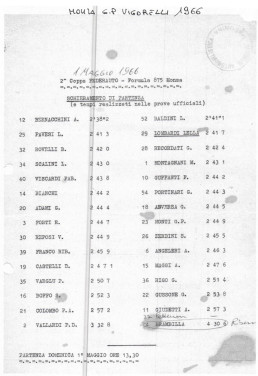
she managed to make it to Formula One, running a dozen races and perhaps more in that category, with the record of being the only woman, in the entire history of the top category, to get a score in the drivers’ world championship and also for this, she entered the history of the Formula One world championship.
Maria Grazia Lombardi, called Lella, now races in the sidereal interspaces of the infinite Universe, but I am sure that wherever on Earth there is a track, a roar of engines and a scent of burning tyres and oil, there dear Lella is present in the memory of a time that was and for which she fought hard and successfully!
Fabrizio Viscardi is a driver who raced F.875 MONZA ALLA VARIANTE JUNIOR – ANNO 1966 SCUDERIA JOLLY CLUB MARIO ANGIOLINI, a race in which Lella Lombardi was also present.
Biraghi 850
Lella Lombardi’s Formula 850 got a new lease of life and returned to racing circuits.
Luciano Biraghi built several Formula 850 cars from 1966 to 1968, and 9 of them were registered with the CSAI.
Of these 9 cars, 2 (the 67.4 and 67.5) were registered by him in his own name and he made them available to his drivers, while the others were sold to private drivers.
Since 1967, Lella Lombardi participated in some races, both on the track and uphill, with one of the two cars that Luciano Biraghi kept for the team, the 67.4.
In 1968 Luciano Biraghi built the last two cars, one of which was specially for Lella. The car had chassis number 68.1 and the certificate of origin lists Lella Lombardi as the first owner.
The car of champions
Lella Lombardi competed with this car from 1967 to 1969, achieving many important goals with it. In fact, she won the Italian championship in 1970 by winning four races and came second in 1971 by winning one race.
Then the car was bought by Orazio Ragaiolo who won the Italian championship in 1972 winning 4 races and one race in 1973.
It was then passed to Giacomo Ballarino who won a race in 1975 and a race in 1977, the last season of the F850 championship.
In 2019 the car was bought by Tommaso Bussani who still competes with it on a number of circuits today.
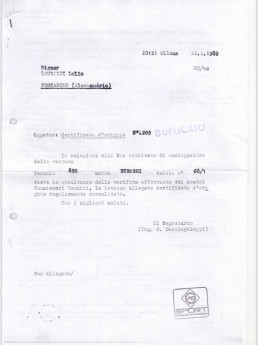
Strongly passionate about these extraordinary cars, their incredible builders and drivers who for more than ten years have animated a nourished and fought championship like no other category has ever done, Tommaso Bussani, together with some friends from Perugia, decided to give life to the Registro Formula 850.
Hence the desire to set out in search of a Formula 850. After various searches he finally found a Biraghi in Monza, very beautiful and well maintained, restored 10 years earlier.
As a true enthusiast, he saw 68.1 on the chassis and inquired to get the ACI sport certificate of origin and found out the history of that car.
So he learned that he owned a car belonging to Lella Lombardi and decided to find out more about her and the competitions in which she participated.
He also got in touch with Luciano Biraghi, builder of the car itself, from whom he learned many anecdotes, about the races and the cars.
To this day, Tommaso still races with Lella Lombardi’s Formula 850, keeping her gritty spirit alive on the track. He participated in the first edition of the reborn Formula 850 trophy in 2021, winning two races and coming second in the overall standings.
Previous
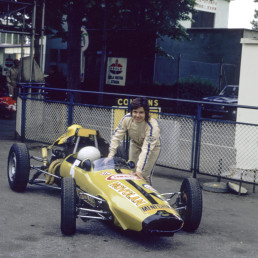
Next
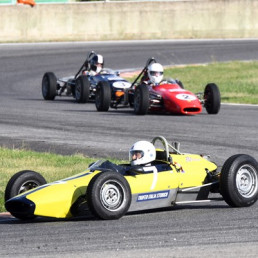
Luciano Biraghi and Lella Lombardi
In the video, Luciano Biraghi recounts the period when he built Formula 850 cars, including the one in which Lella Lombardi raced.
Interview with Giusy from Lella Lombardi Autosport
I met Lella in November 1987. Months earlier she had sought out my husband Bruno, whom she had met in 1982, when he was working at Elio Imberti’s and she was racing the Alfa Romeo GTV in the European Touring Car Championship. They had shared two successful years, but as she could no longer race ‘full time’ (she had already discovered her illness), she decided to look for a trusted person who could help her stay in racing. Her wish was to open her own team and she asked Bruno for his collaboration.
We then lived in the province of Bergamo and she lived in Crema. Lella had already found a shed with a cottage near her and we decided to move to the area.
I still remember that on the day of our meeting in Crema there was a dense fog, as there is no more now, and coming from Bergamo we got lost…we phoned Lella to fix a meeting point and she immediately came to our rescue.
She had a beautiful smile and the first impact for me was very positive.
Both in life and as a driver, she was very demanding, first and foremost with herself and therefore sought the same attention and precision in the people around her. She was characterized by seriousness, sincerity, dedication, but at the same time collaboration and willingness to listen…She was also a good eater with a lot of joie de vivre to make her dreams come true.
What was the most significant event for me as a driver is difficult to recount, especially since I unfortunately met her at the end of her career and she never boasted about her achievements, despite having achieved so much. Everything she had achieved she had earned with hard work and so it was always important for her to reach the next goal and always do more.
I remember her telling me that in the early years of racing, she would load the car into the van that she drove herself and when she arrived at the racetrack, she would unload the racing car, all by herself. She even used to sleep in the van so that she would have some extra money to spend on the race car.
She also said that she remembered with joy the races she did in America on the oval and city circuits with cars like the Chevrolet Camaro, that she almost needed a ladder to get on it (because of the high wheels) and take the driver’s seat. She remembered how people abroad recognized and appreciated her, but also how she wanted to race and make a name for herself in Italy. With courage she decided to return to racing in Italy, but she remembered with bitterness the difficulty of being accepted in an all-male world…
Sometimes she said that if she had stayed in America she would have become rich and famous, because of all the opportunities she had been offered, but her homesickness for Italy and her desire to be accepted in a purely male sector had prevailed.
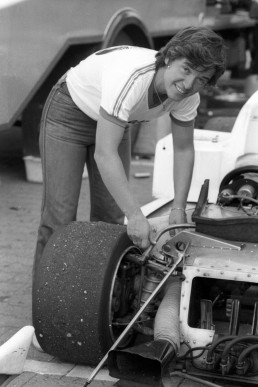
Our collaboration began at the end of 1987 when, as I mentioned above, we moved to Capralba (this was the name of the small town where Lella had found a shed with a cottage). I remember that everything had to be set up and we worked a lot side by side to get the structure up and running and prepare the cars for the next races. In March 1988 we took part in the Italian Touring Car Championship (with Ford Sierra Cosworth GRNs), and it was an immediate success for all of us. At the end of the season we won our first Italian title in the category, bringing rookie drivers to success. In the following years we won other titles with drivers brought in by Lella.
She took care of the drivers and sponsors, while Bruno and I and all the guys in the team managed the organizational and technical side until she passed away in March 1992. Lella used her experience to listen to and help the drivers who competed for us, even revealing little secrets that could be decisive in exploiting a slipstream or performing an overtake. I still remember her mimicking the two paired cars with her hands and then describing the overtake with a beautiful smile, with the same joy and enthusiasm as if she had actually been driving.
She was an excellent test driver and even though she could no longer race due to her illness, she loved testing the cars we prepared. She was really sensitive and attentive and could feel the difference in every little change that needed to be made to the car. That’s why many drivers often relied on her to set up their car, only to be faster in the race with the changes she requested.
In addition to working together, we also had nice holidays on Lošinj (an island in the former Yugoslavia), where she had some friends and a small boat from which she loved fishing.
I remember one evening at dinner in an open-air restaurant, a gentleman sitting at a table opposite ours stared at her with some insistence, she turned to me to express her discomfort… Everything was resolved with a good laugh and an autograph from Lella to the stranger, who towards the end of the evening found the courage to declare himself a great admirer of Lella. She, so reserved and shy, was astonished to be recognized.
Lella was a great fighter both in her professional life and in private. When she discovered her illness (a breast cancer), she did not lose heart and, in order not to abandon her greatest passion, founded Lella Lombardi Autosport to continue living her dream as a driver and to continue racing.
I was very close to her during that period; we used to go together for check-ups and with me she was able to talk calmly about her health, even managing to ‘play it down’. For example, I remember the time when, after a round of chemotherapy where she unfortunately lost all her hair, we went together to choose a wig and she had fun trying on every length and colour that day, and we spent a peaceful afternoon together.
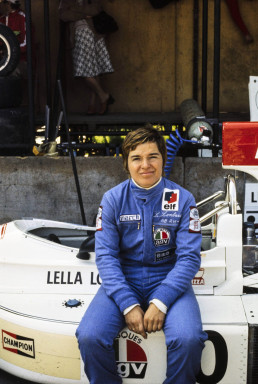
A phrase she loved to say was: ‘everything you have must be earned with hard work and sacrifices, because only then will you know how to appreciate every moment of “glory” and, at the same time, you will have the strength to overcome the difficulties that in every field life holds in store for you…’
This is the lesson that probably best sums up Lella’s life.
In a world where everything seems easy and acquired by right without effort, it is good to bear these words in mind.
Sometimes I still wonder what Lella would say about this world of racing, perhaps after so many years not much has changed for women. But let’s look to the future and hope that her story succeeds in rubbing off on today’s young people with her grit and tenacity.
To the present day, Giusy still looks after Lella Lombardi Autosport, managing the accounts.
Her wish is to carry on Lella Lombardi Autosport so as to keep alive the memory of a driver who gave so much to the world of racing, with grit and passion.
Interview with Arturo Merzario
Apart from a small parenthesis, I have never had a direct relationship with Lella Lombardi, although we participated in a few races together.
That is why I had little opportunity to get to know her, except occasionally in some races. She raced the Osella 2000-litre prototype. I knew Osella (mechanic) very well, as I helped him make a name for himself. In ’72 I won the European championship racing his cars and in ’73 I came second. So we were often in the same environment and I heard about her.
I didn’t have a close relationship of friendship or much confidence with her, who was always very reserved and friendly. Of course there was no lack of greetings, hugs and photos together as colleagues in the industry.
At the time, considering that she was a woman on the race track, she certainly did not go unnoticed. She was one of the few who stood out.
Women in the motorsport world were seen in a different light, and I can confirm this first-hand, because they did a job that was considered for male, tomboyish, only.
As a woman, she made people talk about her and she got noticed, but she was actually really good. A lot of people in those years tried, but there were very few who did as well as she did.
In the last 30 years there have been more women in the industry, but at the time it was a really closed sector. Furthermore, in those years, motor racing was the preserve of rich people and without money it was very difficult to get into the industry, afford the cars and participate in the races.
Lella is proof that, with strength and dedication, one can achieve important goals, despite prejudices, the difficulties of being a woman and having to manage money sparingly. She was a great driver!
To stand out in such a competitive environment as motor sport you needed the ‘right foot’, knowing how to push on the accelerator and reach the finish line. Those who were fast and talented in their own right knew how to stand out.
We were both present at the Spanish Grand Prix at the Montjuic circuit and, unlike Lella, I withdrew in protest at the poor safety conditions at the circuit, despite the fact that we had to honour our commitment to the organizers, to race and put on a show.
During the three qualifying laps, we decided to retire after the first lap.
Due to a serious accident, the grand prix was stopped and since the participants had only run 50% of the race plus one lap, the organizers decided to award only half of the points. Therefore, Lella Lombardi only got 1?2 point in Formula 1. Not because she was less good or because she was a woman, but it was the organizers’ decision for all drivers in the race. Lella was in fact the first woman to achieve this important milestone.
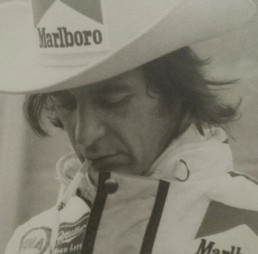
Later I took part in other races with Lella, such as the Grand Prix of the Mediterranean at the Pergusa racetrack (Enna), in Sicily, the European 2000-litre sport prototype championship as well as Formula 2.
We also participated together in the 1000km of Monza and I remember that I was racing with Ferrari at the time. These are just some of the races we both participated in, but it is difficult to remember them all after so many years.
Arturo Merzario is a former Italian racing driver, who raced in all disciplines from small touring cars to Formula 1, leading Alfa Romeo to victory in the 1975 Sport Prototype World Championship.
Formula Ford 1600 Tecno-Pirola
Another car with which Lella raced during the 1970s, still in excellent condition.
This is the Formula Ford 1600 Tecno-Pirola from 1972 chassis 002/72, one of two Tecno chassis modified and set up by Pirola.
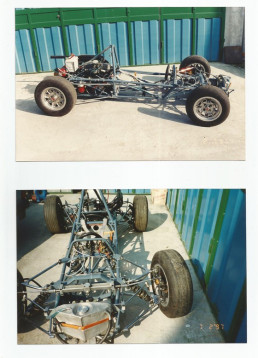
This car was bought by a private owner, Pirola’s friend, in the 1990s and restored for hobby and collectors’ purposes. It was also exhibited at Autostory at the time and has remained in the garage ever since.
During the restoration, an earlier livery with the inscription “Lella Lombardi” on the sides emerged and, thanks to testimonies of the time and archive photos, it was possible to partially reconstruct the racing history of this car, in which Lella Lombardi – Pirola’s friend, too – and Giorgio Francia or Monguzzi raced (there is no certainty as to which of the two raced on chassis 001, which was destroyed, and which on this one, 002).
The car was recently inspected by Formula Ford experts, who assessed the car’s condition as excellent and faithful to the original.
Unfortunately, there is no documentation on the car’s origin or certificate attesting to its previous owners and thus to its ownership by Lella Lombardi, as many things have been lost over the years.
Nevertheless, we do have a vintage photo showing Lella Lombardi with a Tecno Formula Ford in which she raced in the 1970s, which is precisely the car in question.
Pictured is the restored car now, and the vintage photo showing Lella Lombardi with the car.


The memory of Elio Imberti, Lella Lombardi's trainer in the European Touring Car Championship (1982-1984)
I got to know Lella Lombardi through another driver for whom I was looking after the car around 1982.
Anna Cambiaghi had taken a Delta car and had raced for them. At the time, Delta was following Formula One cars and didn’t have time to take care of her car as well. So they advised her to find a mechanic and gave her the car anyway.
Anna Cambiaghi called me and decided to give me the car, to prepare it for the race that was to be held shortly thereafter in Rome for the European Touring Car Championship. On that occasion, Lella Lombardi would also participate in the race.
Lella was driving an Alfa Romeo, but it wasn’t going very well; in fact she didn’t get any memorable results in that race. So I offered to make some modifications to make the car go faster, so I also took Lella Lombardi into the team.
In the following race, in England, the car doubled the second. The performance was so astonishing that the Audi team made a complaint to have the car checked to see if the engine complied with the regulations.
The Audi team was so impressed by the speed of Lella’s car that they feared the engine was over the allowed capacity.
In England, once an inspection had been requested, it was customary to agree on a figure between the parties, proposed by the person subject to the inspection. If everything then went smoothly, the one who requested the check would have to pay it to the other. Otherwise, if irregularities were found, then I would have to pay the sum.
Being confident that I was right, and that I had only made improvements to the car, I proposed 6 million Lire as a figure. Audi believed it was a bluff to avoid the inspection and agreed.
The next day, engineers from Germany would arrive for the inspection.
Audi’s reasoning, however, was straightforward: the car wasn’t going fast before, even if the Delta was running it, now that a village mechanic was looking after it, how did he do it? Surely he must have used a 3000 engine instead of a 2500.
The technicians disassembled everything and actually verified that the car was smooth. At the end the Audi engineer said: ‘We disrespected you, you could tell that to the newspapers to make yourself known and show how good you are’ but I said nothing out of respect and they thanked me. Of course, from then on there were more checks, but they were never requested by the Audi team.
We came home with the engine in pieces, but I would have had to overhaul it before the next race anyway. The overhaul is essential before every race because each check allows the car to perform better.
If you don’t change the engine after a certain number of kilometres then it breaks down.
That race in England was the 3rd race of the European Championship and every time they did engine checks. We won many races with that car, even ahead of names like BMW.
Having a well-performing car and a good, spirited driver is the necessary combo to reach the finish line and victory.
I have had many drivers and none were as fast as Lella Lombardi.
She had an innate sensitivity for understanding the car. She perceived every single change, even the most minute and imperceptible one.
The Alfa Romeos were Auto Delta’s but I had them on loan and took care of their maintenance.
For each circuit we had to set up the car, change the springs, shock absorbers. Lella raced in the same car as the test driver of the Delta car, but she had a unique feeling for understanding the car and its set-up. I tried to follow the directions of both of them, but with Lella’s directions the car ran better. Not only was she a good driver on the track, but also in the preparation phase she was connected to the car in a special way, she was precise, sensitive and determined. Every indication she gave was specific and always aimed at making improvements. Drivers often ask for minimal changes, maybe then they don’t notice anything but still want to be heard by the mechanic. In the capacity of mechanics, in order to make the drivers happy, we used to say that we had made modifications even when maybe nothing had changed, but in this way the drivers were happy. In those cases, you could really realize that they didn’t feel the car at all.

With Lella it was different; when I didn’t follow the directions to the letter she knew instantly. She was the best at listening to the car and setting the best set-up. I have met very few drivers like her in my career. We worked together for a little over four years before she retired.
Augusto Rossetti, driver of Lella Lombardi Autosport team
Lella always followed and supported me during every race and especially in the preparation phase.
She was a very sweet person, with lots of ideas and above all a great deal of car experience, which she always made available to offer advice and always improve me. She shared everything she knew, you could see that she was happy for continuing in motorsport industry, even without racing any more, but allowing someone else to carry on that dream.
Nowadays, it is easier for women to enter the industry, there are many women racing. At that time, they used to be viewed badly, discriminated against and marked by prejudice. Lella was like a black swan, a woman in a male-only environment. Unfortunately, that was the common mindset.
Getting half a point was not easy for her. Not only were there difficulties and negative judgements, but at the time there were only a few really competitive qualifying races. Today there are twice as many qualifying races and more places to get awards.
In spite of this, she was really strong in her abilities and knew where she wanted to go, she never let it get her down, and she also showed this determination with us drivers in the team, to encourage us never to give up, with a mix of determination, gentleness and sensitivity that always distinguished her.


